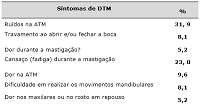Prevalence of temporomandibular dsorders and association with psychological factors in students of undergraduate Dentistry students
Keywords:
temporomandibular joint dysfunction syndrome, anxiety, depression, student.Abstract
Introduction: the approach of biopsychosocial factors have gained prominence when considering the multifactorial nature of Temporomandibular Disorders but some studies present conflicting results as to its relationship with psychological factors.
Objective: to determine the prevalence of signs and symptoms of this disorder and its association with emotional stress, anxiety and depression in college students of Dentistry course.
Methods: therefore, we randomly selected 135 volunteers from a Brazilian public university, from a total of 344 undergratuate dental students. Exclusion criteria were: absence of two or more teeth (excluding third molars); use of a removable prosthesis; use of orthodontic appliances (fixed or mobile), at the time of the study; participants treated for orofacial pain or dysfunction; not signing the free and informed consent. The signs and symptoms of temporomandibular dysfunction were collected through a form with an appropriate history questionnaire and a clinical examination protocol. To estimate the presence of psychological factors we used the scale Hospital Anxiety and Depression, translated and validated to Portuguese. Data were tabulated and analyzed descriptively and statistically. Associations between variables, emotional stress, anxiety, depression and dysfunction were verified by statistical tests chi-square (x2) and Fisher's exact, with p< 0.05.
Results: 76.3 % had dysfunction, and in 54.1 % it was considered mild, while in 22.2 % were observed active treatment needs. 34.1 % of the sample had only affected joint clinical signs. Emotional tension is statically associated with the presence of disorder and need of treatment. Anxiety and depression are associated only with the need for treatment.
Conclusion: the prevalence of Temporomandibular Disorders in the sample of college students was high, with higher frequency of joint clinical signs and associated with the female gender, emotional stress, anxiety and depression.
Downloads

Published
How to Cite
Issue
Section
License
Authors retain all rights to their works, which they can reproduce and distribute as long as they cite the primary source of publication.
The Rev Cubana Estomatol is subject to the Creative Commons Attribution-Non-Commercial 4.0 International License (CC BY-NC 4.0) and follows the publication model of SciELO Publishing Schema (SciELO PS) for publication in XML format.
You are free to:
- Share — copy and redistribute the material in any medium or format.
- Adapt — remix, transform, and build upon the material.
The licensor cannot revoke these freedoms as long as you follow the license terms.
Under the following terms:
Attribution — You must give appropriate credit, provide a link to the license, and indicate if changes were made. You may do so in any reasonable manner, but not in any way that suggests the licensor endorses you or your use.
- NonCommercial — You may not use the material for commercial purposes.
No additional restrictions — You may not apply legal terms or technological measures that legally restrict others from doing anything the license permits.
Notices:
- You do not have to comply with the license for elements of the material in the public domain or where your use is permitted by an applicable exception or limitation.
- No warranties are given. The license may not give you all of the permissions necessary for your intended use. For example, other rights such as publicity, privacy, or moral rights may limit how you use the material.

